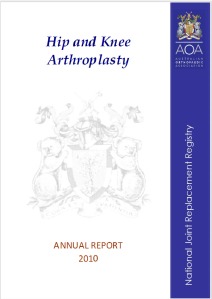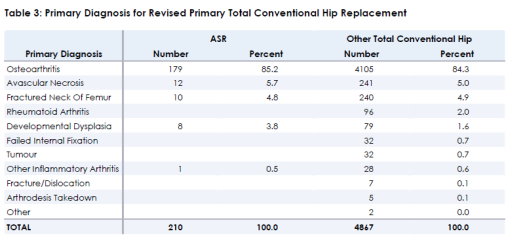Tags
Australia, Cumulative incidence, DePuy, Hazard Ratio, Hip Replacement, joint replacement, Prosthesis, surgery
ASR Total Conventional Hip Acetabular Prosthesis
 This analysis compares the ASR Total Conventional Hip Acetabular Prosthesis with all Other Total Conventional Hip prostheses. This Acetabular Prosthesis has been identified as having a significantly higher revision rate.
This analysis compares the ASR Total Conventional Hip Acetabular Prosthesis with all Other Total Conventional Hip prostheses. This Acetabular Prosthesis has been identified as having a significantly higher revision rate.
For a detailed explanation of the process used by the Registry that results in identification of prostheses that have a higher than anticipated rate of revision please refer to the ‘ Prostheses with Higher than Anticipated Rates of Revision ‘ chapter of the most recent AOANJRR Annual Report, http://www.dmac.adelaide.edu.au/aoanjrr/publications.jsp.
TABLE 1: Revision Rate of Primary Total Conventional Hip Replacement.
The Revision Rate of the ASR Total Conventional Hip Acetabular Prosthesis is compared to all Other Total Conventional Hip prostheses.

TABLE 2 Yearly Cumulative Percent Revision of Primary Total Conventional Hip Replacement
The Yearly Cumulative Percent Revision of the ASR Total Conventional Hip Acetabular Prosthesis is compared to all Other Total Conventional Hip prostheses.

FIGURE 1 Yearly Cumulative Percent Revision of Primary Total Conventional Hip Replacement
The Yearly Cumulative Percent Revision of the ASR Total Conventional Hip Acetabular Prosthesis is compared to all Other Total Conventional Hip prostheses. In addition, Hazard Ratios are also reported.
Hazard Ratios are reported for specific time periods during which the Hazard Ratio is constant. This is done to enable more specific and valid comparisons of the risk of revision over time. The pattern of variation in risk has important implications with respect to the underlying reasons for any difference.
TABLE 3 Primary Diagnosis for Revised Primary Total Conventional Hip Replacement
This table identifies the diagnosis of the primary procedure which was subsequently revised. This information is provided as there is a variation on outcome depending on the primary diagnosis. It is therefore important when considering the reasons for a higher than anticipated rate of revision that there is identification of the primary diagnosis. This information should be compared to the primary diagnosis for the revisions of all Other Total Conventional Hip prostheses.

TABLE 4 Revision Rates of ASR Primary Total Conventional Hip Replacement by Fixation.
This analysis is provided as some prostheses have more than one fixation option. Additionally there are prostheses where an alternative to the recommended approach to fixation was used e.g. a cementless prosthesis that has been cemented or vice-versa.

TABLE 5 Revision Rates of ASR Primary Total Conventional Hip Replacement by Bearing Surface.
This analysis is provided as some prostheses are combined with a variety of different bearing surfaces. All bearing surfaces used with this Acetabular Prosthesis are listed.

TABLE 6 Type of Revision Performed for Primary Total Conventional Hip Replacement
This analysis identifies the components used in the revision of the ASR Total Conventional Hip Acetabular Prosthesis and compares it to the components used in the revision of all Other Total Conventional Hip prostheses.
The reason this analysis is undertaken is to identify whether there is one or more components which are being replaced that differ from the components replaced for revisions of all Other Total Conventional Hip prostheses i.e. is there a difference in the type of revision undertaken for the ASR Total Conventional Hip Acetabular Prosthesis compared to all Other Total Conventional Hip prostheses.

TABLE 7 Reason for Revision of Primary Total Conventional Hip Replacement
This is reported in two ways; a percentage of all revisions and also as a percentage of all primary procedures. This analysis includes a comparison of reasons for revision to all Other Total Conventional Hip prostheses.
This analysis is undertaken to identify if there are differences in the reasons for revision and the number of revisions performed for those reasons between the ASR Total Conventional Hip Acetabular Prosthesis and all Other Total Conventional Hip prostheses.

FIGURE 2 Revision Diagnosis Cumulative Incidence by Time to Revision for Primary Total Conventional Hip Replacement
This figure details the cumulative incidence of the most common reasons for revision. The five most common reasons for revision are included as long as each of these reasons account for more than 10 procedures or at least 5% of all revisions for the ASR Total Conventional Hip Acetabular Prosthesis . A comparative graph is provided of the cumulative incidence for the same reasons for revisions for all Other Total Conventional Hip prostheses.

TABLE 8 Revision Rates of Primary Total Conventional Hip Replacement by State
This enables a state by state variation to be identified for the ASR Total Conventional Hip Acetabular Prosthesis and provides the comparative data for each of the states for all Other Total Conventional Hip prostheses. This analysis is undertaken for similar reasons as those outlined above for Table 7.

TABLE 9 Number of Revisions of ASR Primary Total Conventional Hip Replacement by Year of Implant
This analysis details the number of prostheses reported each year to the Registry for the ASR Total Conventional Hip Acetabular Prosthesis. It also provides the subsequent number of revisions of the primaries reported in that year.
Primary procedures performed in later years have had less follow up time therefore the number revised is expected to be less than the number revised in earlier years. For example, a primary procedure performed in 2009 has a maximum of one year to be revised, whereas a primary performed in 2007 has a maximum of three years to be revised.

TABLE 10 Revision rates of ASR Primary Total Conventional Hip Replacement by Catalogue Number Range
Many prostheses have a number of catalogue ranges. The catalogue range is specific to particular design features; more than one catalogue range usually indicates a minor difference in design in a particular ASR prosthesis.
This analysis has been undertaken to determine if the revision rate varies according to the catalogue number range.

TABLE 11 Revision rates of ASR Primary Total Conventional Hip Replacement by Component
A prosthesis may be combined with multiple components. This analysis has been undertaken to determine if the revision rate varies according to the component with which it is combined.

Source Document:
Related articles
- Primary Total Resurfacing Hip Replacement – Extracts from Australian Orthopaedic Association National Joint Replacement Registry – Annual Report 2010 (earlsview.com)
- Australian Orthopaedic Association National Joint Replacement Registry – Annual Report 2010 (earlsview.com)
- Extracts from Australian Orthopaedic Association National Joint Replacement Registry – Annual Report 2010 (earlsview.com)
- Recalled DePuy ASR Hip Implant Failure Leads to Lawsuit Filed by the Law Offices of John David Hart (earlsview.com)
- How to Choose a Hip Or Knee Replacement Surgeon & Prosthesis (earlsview.com)
- Bone Loss Following Hip Replacement – in Acetabular Region in A Woman with Breast Cancer (earlsview.com)
- Revision Hip Replacement (RHR) (earlsview.com)
- Australian TGA Response to Recall of DePuy ASR Hip Replacement (earlsview.com)
- Metal on Metal Hips – Extracts from Australian Orthopaedic Association National Joint Replacement Registry – Annual Report 2010 (earlsview.com)
- Radiographic Assessment of the Patient With a Total Hip Replacement (earlsview.com)
- Associate Professor Michael J. Neil – Doesn’t Recommend Resurfacing (earlsview.com)
- Recovery Benefit of MIS THA to Give a Faster Functional Recovery Not Proven (earlsview.com)


Pingback: Hip replacement and hip revision « Earl's View
Pingback: Revealed: Britain’s top surgeons for hip replacement « Earl's View
Pingback: Revision Hip Replacement « Earl's View
Pingback: Total Hip Replacement in the Dysplastic Hip: The Use of Cementless Acetabular Components « Earl's View
Pingback: Hip revision surgery « Earl's View
Pingback: Hinge knee prostheses yield pain relief, good stability and functional outcome « Earl's View